YAM Re-Org
Specification Document
| Info | |
|---|---|
| Project Name | Yam Re-Org |
| Author | Ross |
| Date | Sept. 14, 2022 |
| Discord Handle | Ross 🍠#2221 |
| Status | [draft] |
| Discourse | Yam Re-Org Specification Doc Discussion |
| Snapshot | [Insert link when available] |
This document serves to make the goals, requirements, scope, and risks of a new project clear in order to help inform YAM token holders when making decisions about funding work to build it.
Project Summary 📝
What is the goal and purpose of the project?
This project aims to build a new framework for the YAM DAO to facilitate better transparency, accountability, and permissionless-ness. It does so by developing a new process by which projects can receive funding. It will clarify the governance process, define and limit the roles of core contributors, and provide an example structure for how DAO-funded projects can be run.
What problem does the project solve?
YAM has struggled to find its purpose and to retain mindshare and contributors. We believe that the causes of this are multi-faceted, including a lack of vision around the mission of the DAO, lack of thought and investment in the core organizational infrastructure of the DAO, an inability to enforce accountability, and confusion around management of projects.
In the past, when token holders wanted something done, they proposed a vote and expected someone on the ‘core team’ to fulfill the task. This lead to situations where certain elements of the community expected things from others without any prior agreement. Contributors were put into working situations they didn’t expect and hadn’t signed up for. The grants system changes this. Grant recipients can work the way they want with the team they want, as long as it is agreed upon in the grant contract. They are their own boss, but with a contractual responsibility to YAM token holders.
YAM / Ecosystem Benefit
The benefit of this work to the YAM ecosystem is that it will provide the foundation for a better functioning DAO and to then test that framework. YAM contributors have been focused on building products that will bring revenue into the treasury, but we have been doing it in a haphazard way with little structure or oversight. This has lead to delays, confusion, stagnation, and an inefficient use of treasury funds. This re-organization attempts to solve the deeper issues present in the structure of the DAO that have hampered progress so far. Additionally, In using the process proposed to do the work, we are also testing its robustness for use in attracting contributors to propose grants in the future.
Design and Project Scope 🏗️
Project Scope
What are the different elements that need to be built or designed to complete this project?
The scope of this project consists generally of the following elements
- Design of a new operational and organizational structure for YAM based on a grants model that empowers token holders to make big picture funding decisions and individual actors or groups to apply for funding to do self-directed work for the DAO.
- Full documentation of how a new operating and organizational structure based on a grants model will work and how to use it. This will be via documentation style website.
- Example documents and templates for users of the system to reference.
- High level documentation explaining the new system and rationale to token holders who must decide whether they wish to continue to implement it. This will be in the form of a website with blog style posts.
- Design of a "Governance Repository" system to manage and record the decisions and documents produced from running the system. This would be a public documents repo where governance and grant proposals are published.
Alternatives Considered
Are there other potential ways to solve this problem? Why choose this one?
There are a myriad of ways to try and solve these problems and lots of different DAOs are working to do so. We believe that any solution to these problems must allow YAM to continue to operate with the same ethos that it has in the past: A permissionless, decentralized organization that puts fairness and experimentation at the forefront and doesn’t take shortcuts. We are interested in exploring a system that holds true to these ideals and also functions effectively and accountably.
In doing so, we will make the following assumptions about how the DAO must operate:
- Anyone
MUSTbe able to freely join and leave the DAO at any time. - The DAO
MUSTnot be technically constrained by a limit to the number of token holders or the number of actors who are able to participate in governance. - The DAO
MUSTnot be succeptible to an actor or actors who can exert control over the DAO outside of the accepted mechanisms, namely token voting. - Anyone who wishes to contribute to the DAO
MUSTbe able to apply to do so and their acceptance and compensationMUSTbe be determined by DAO members (token holders). - All information necessary to participate in the DAO
MUSTbe publicly available. - Participation in the DAO
SHOULDnot be prohibitively expensive in either time or money.
Project Requirements
Describe what characteristics the project
MUST,SHOULD, andCOULDhave.
In addition to the assumptions listed in the section above, the ReOrg must have the following additional requirements:
When complete Token Holders
MUSTbe able to understand the new system well enough to vote to implement it. Once implemented, they should be able to use the current communications and voting infrastructure to make decisions about distributing grants to applicants.When complete, token holders
SHOULDknow how the system facilitators (governing council) are elected and be able to elect the facilitators they choose via that mechanism.When complete, grant recipients
MUSTbe able to understand how to successfully submit an application for a grant and how to go through the process to receive a grant. They must be able to go through this entire process using the provided DAO infrastructure.When complete, the facilitators
MUSTbe able to successfully guide both token holders and grant recipients through the entire process using the provided infrastructure.The design
SHOULDbe general enough that it can work if a new on-chain voting mechanism is implemented or governance processes are upgraded or migrated to another chain or "layer 2".The design
SHOULDrequire a similar level of governance participation to what the DAO currently has, even if the aim is to increase that participations. If the design can work with less governance overhead and acheive the same goals, that is preferred.
Participants 👨🚀
Participants/Users of the Project
List the participants who are expected to use and interact with the project in its expected completed form. Describe what their role is and what skills they need to perform this role.
Token Holders (YAM voters)
Role: Token holders control the Treasury via governance voting. They decide on the large scale decisions around the direction of the DAO and what projects to fund.
Necessary Skills: A token holder should have a basic understanding of how DAOs and blockchains work in order to make good decisions about their development, but not explicit skills are needed. The better educated the token holder, the higher chance that they will govern well.
How they interact with the project: Token Holders must be able to find information about the workings of the DAO. This includes information about the grants that they need to approve and information about the processes to do so. They interact with the project via discord, discussion forums, github, snapshot votes, and on-chain votes. They should have a web-3 wallet (metamask as the standard) in order to store their tokens and vote on governance actions or delegate voting power.
Grant Recipients (builders and developers)
Role: Build, design, and work on specific parts of Yam or projects to make the DAO or the wider crypto landscape better.
Necessary Skills: This varies based on the work they are applying to do for the DAO. They should be able to communicate effectively in English and able to navigate the approvals process and the review processes for their work. They should be able to post a document to Github, or willing to learn how.
How they interact with the project: Grant applicants and Recipients interact with the project via discord and the Discourse discussion forum, as well as via Github to submit work and documents. They may interact with other DAO built tools as they become available.
System Facilitators
Role: They make sure that the above 2 parties are able to coordinate and keep the system and DAO working smoothly.
Necessary Skills: They must understand how the YAM governance process works and be able to guide token holders and grant applicants and recipients through it. The system facilitators who write and vet proposal code should be experienced in writing solidity and using Github to review proposals. They should be able to communicate why a proposal or process may be lacking in completeness.
How they interact with the project: Facilitators will interact using the Discord and Discourse discussion forums for discussions. Some will use Github to review code and may create snapshot and on-chain votes.

User Flow 💧
What is the full user flow for this project. Is this all part of the scope?
Step 1: Project Creation and Definition
Define and specify your project. This is the information that Token holders will use to determine whether to move forward with the project. This is where you pitch your idea and get everyone excited! The primary document for this work is the Project Specification Document (like this one). It can be supplemented with a marketing document if the author believes that will help sell the project to token holders.
Project Specification: More thorough document explaining the workings of the project. Scope, Goals, requirements, users and user flows, risks, comparables, expected deliverables, etc. What exactly is the DAO funding and what will the project do when complete.
Project Marketing Document (optional): High level document that is intended for a more casual audience explaining why this project is cool/important and should be funded.
Once posted to the YAM Forum, YAM token holders should give feedback on whether this is work they want to fund. This feedback should be incorporated into the first grant proposal. The Facilitators (Gov-Ops Council) is available to help with formatting and coordination. They should help the applicant get feedback from important stakeholders to understand what their next steps should be.
🏃 Milestone 1: Post Specification Document and recieve feedback
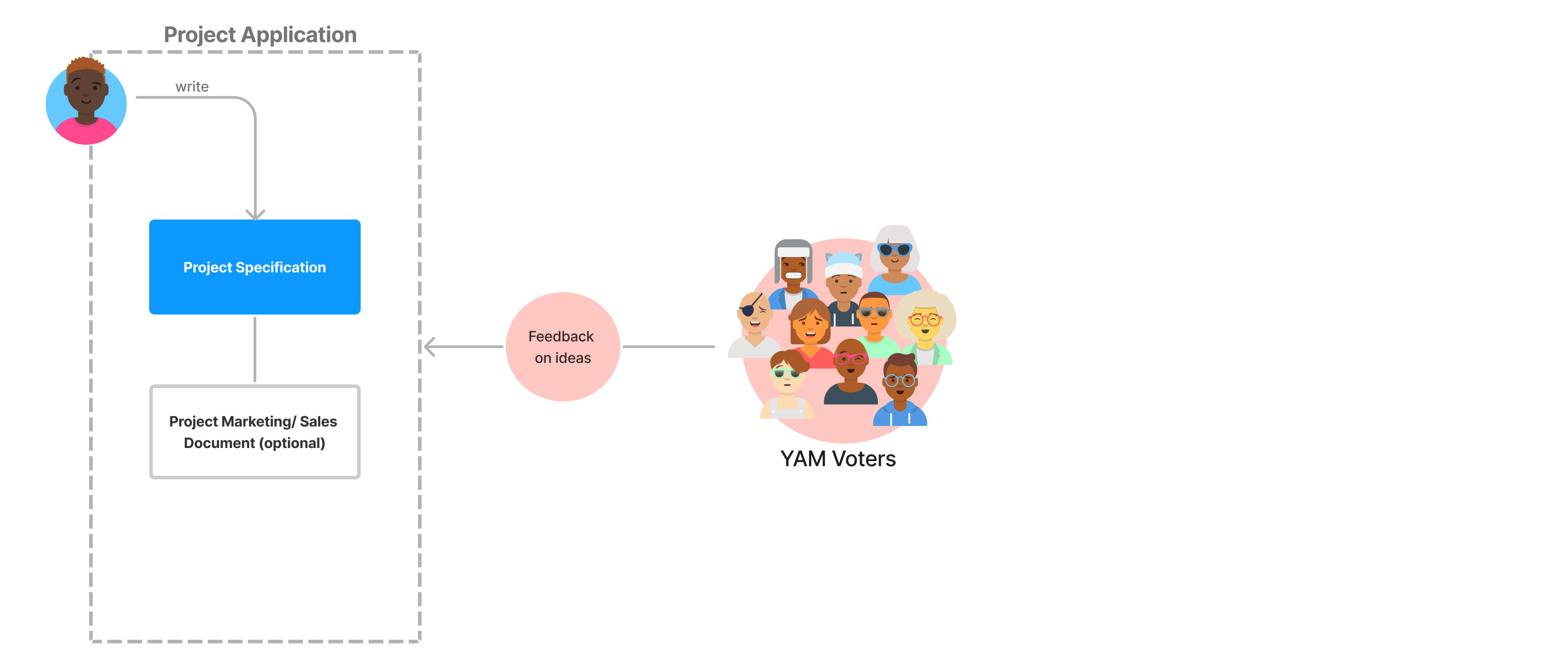
Step 2: Grant Proposal
After recieving feedback on the project, the next step is for the person(s) who plan to work on the project to submit a Grant Proposal. This grant proposal references the project documents, delineates what parts of the project they expect to work on, and makes a specific compensation request and set of deliverables.
There will be a snapshot vote on the Grant Proposal once it has been submitted to the forums. YAM token holders vote to approve a specific grant request to fund work on the project. If they vote YES then the grantee should begin work immediately. If NO then the applicant should revise the application or drop it. If dropped, token holders can shop the project around or wait for someone else to bid on the work.
🏃 Milestone 2: Grant Approval
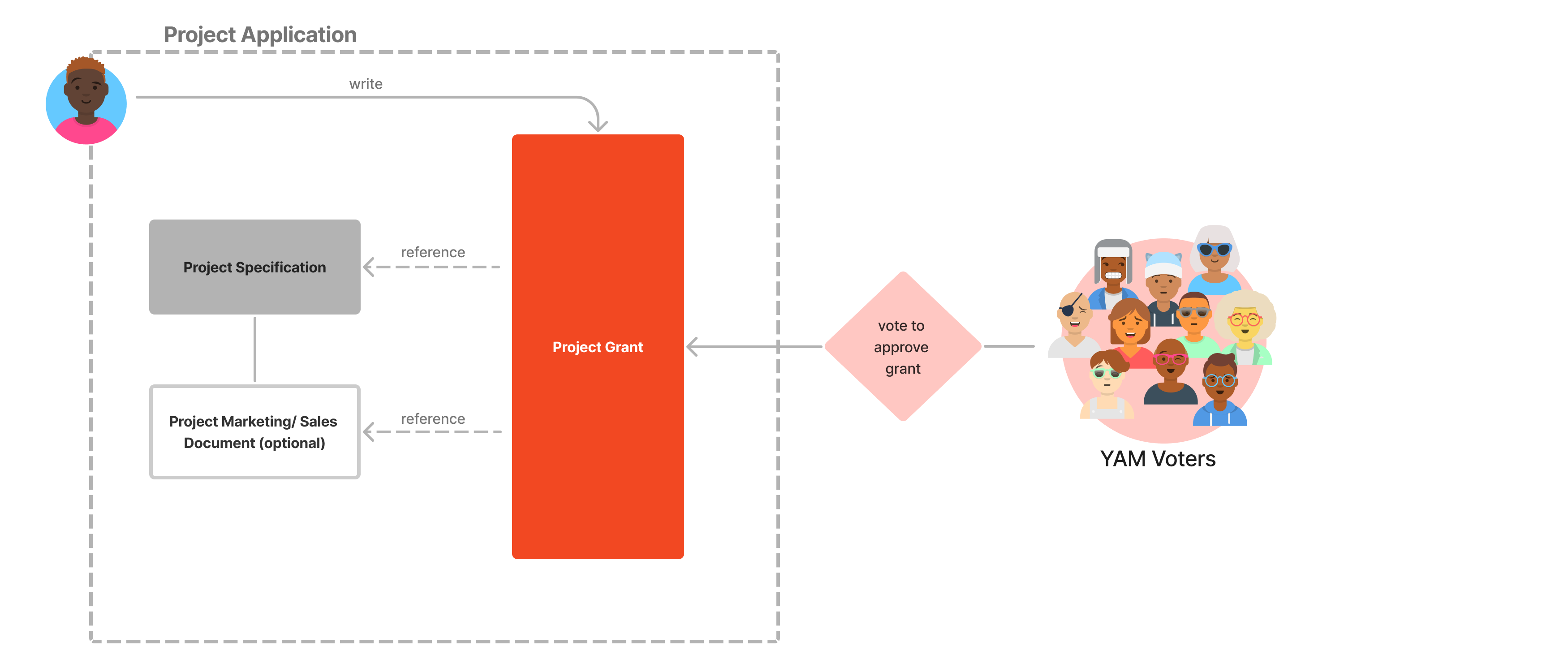
Step 3: Work and Reporting
Grant recipients should now be working on the project. Based on the terms of their Grant Proposal, they will submit intermittent Status/Transparency reports and open-source their code and/or research in order to release grant funds. Grants can be written to fund a specific scope of work, with progress payments along the way. This is typically done on a monthly cadence, with transparency reports submitted in the first 5 days of the month.
🏃Milestone 3: - Progress Report
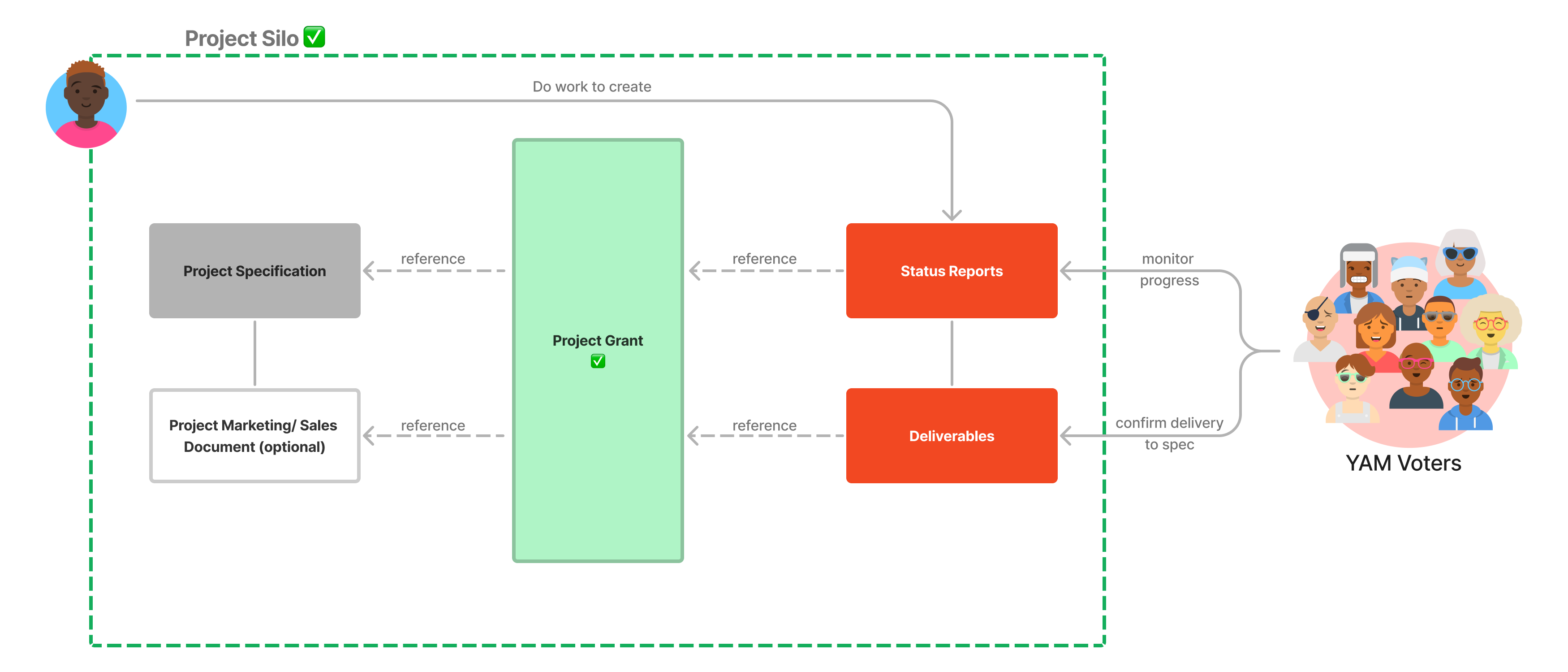
Upon submission of a Status/Transparency report, token holders have a 3 day window to dispute the payment. If it is not disputed, it is added to the monthly on-chain transaction (with the other approved payments), which is executed via a token vote.
🏃Milestone 4: - Grant Payment
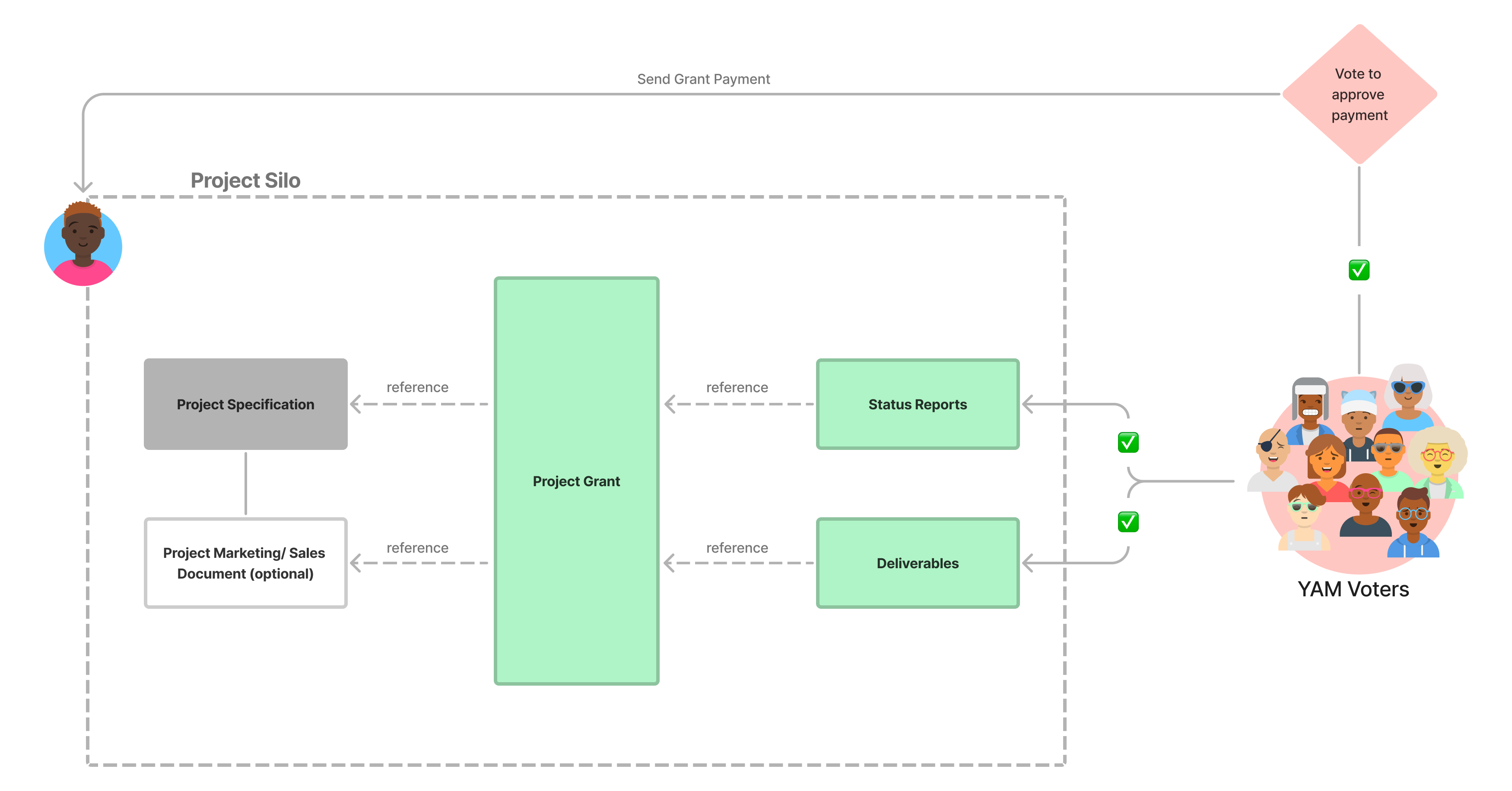
Step 4: Completion and Renewal
After the completion of the work and full payment of the grant, the process can be repeated for additional scope of work by submitting a new Grant Proposal (start over at step 2). This iterative process allows for flexibility in the system and allows token holders to re-affirm their approval of the work being done.
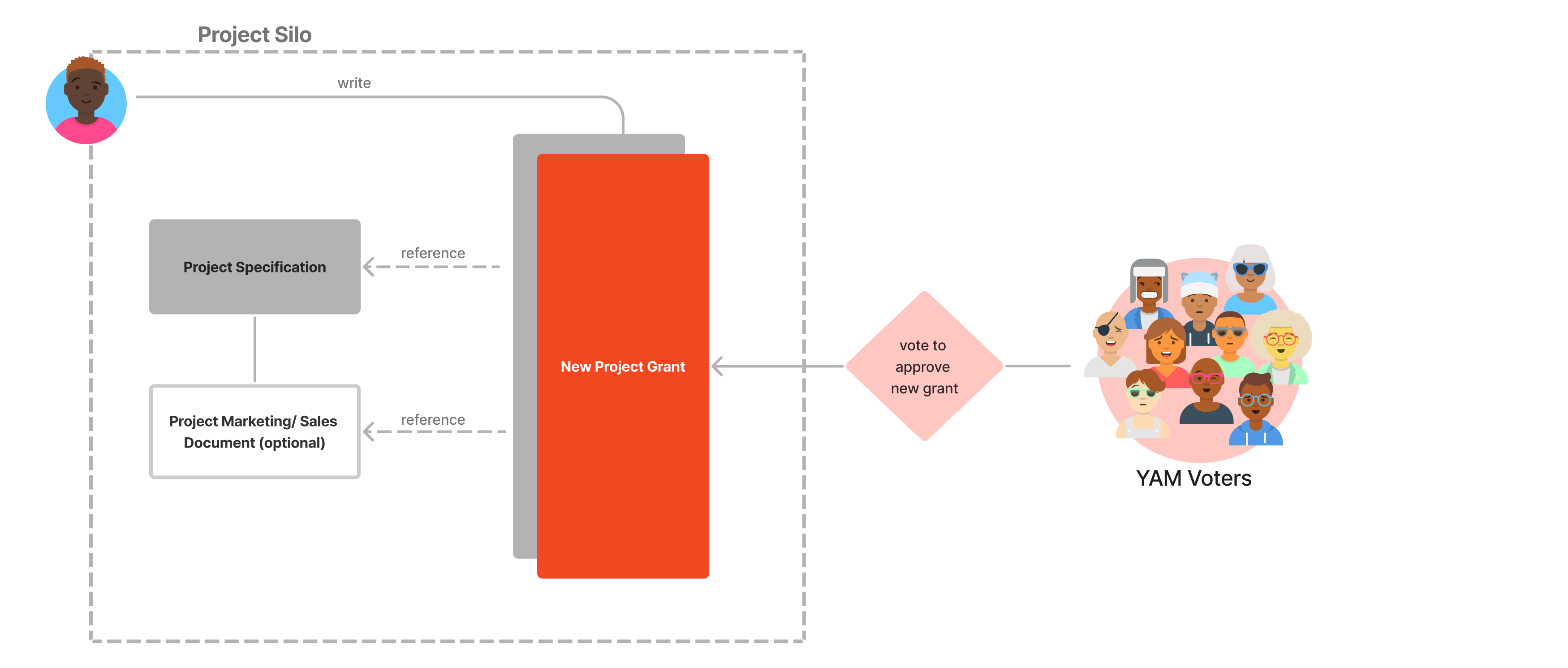
Risks ❗
Dependencies
Are there other projects or contracts that the project will interact with? How will they do so? What are the security risks from these interactions?
This project will utilize the existing YAM governance contracts and governance infrastructure, including Discord, Discourse, Github, Snapshot, and the YAM website. There are limited changes to the way that the DAO interacts with these pieces of infrastructure. The initial version will not make significant changes to how they are used, but may make suggestions about future improvements and changes.
Security Assumptions
What security assumptions need to be made for this project to be successful?
The security assumptions for this project are equivalent to the current YAM security assumptions. This project makes the assumption that YAM token holders are capable of making important decisions about the future of the DAO and how to spend the treasury. It makes assumptions that YAM token holders are capable of vetting projects that it chooses to fund.
Financial Risks
Are there financial risks to either the DAO or to users of the project?
This project does not involve any changes to the way the YAM treasury or YAM token holders interact with the treasury or their own funds. How tokens are stored and used to vote does not change. The authors cannot make any statements about what this project will do for the YAM token price and we consider any gain or loss of value in the YAM token to be out of scope of this proposal.
Comparable Projects 👀
Are there similar examples to the proposal that token holders can use to compare or understand the scope?
There are other projects that utilized similar governance structures and models to what we are proposing, and while those are not directly applicable, they may be helpful to look at to understand what we are trying to achieve.
https://docs.synthetix.io/governance/
https://docs.element.fi/governance-council/council-protocol-overview
Project Time-Frame ⏲️
Please provide a rough estimate of the time expected to fulfill different parts of the scope, as well as full completion of the project. This does not need to detail all parts, but should provide a general overview of how long the project may take. More detailed information should live in grant applications
Projecting a timeframe for this work is difficult as the design portion is hard to predict. But most of the big design questions seem to be clear and mostly answered, and now simply need more documentation, iteration, and implementation. It then needs review and approval by YAM stakeholders, and following that, work to building out some of the necessary infrastructure like a "governance repository" website that will need done, preferably via this grants process.
Additional Information ❓
Please add any additional information here that doesn't have a place to go above and you think is important to fully specify this project.
No Additional info.
❤️ 🚀 🍠
Copyright and related rights waived via CC0.